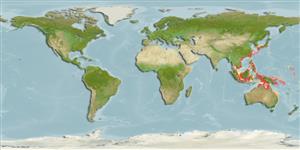Environment: milieu / climate zone / depth range / distribution range
Ecología
marino demersal; rango de profundidad 30 - 40 m (Ref. 9774). Tropical
Northwest Pacific: southern Japan to the South China Sea.
Tamaño / Peso / Age
Maturity: Lm ? range ? - ? cm
Max length : 30.0 cm SL macho / no sexado; (Ref. 9774); common length : 15.0 cm SL macho / no sexado; (Ref. 9774); peso máximo publicado: 169.80 g (Ref. 124479)
Espinas dorsales (total): 0; Radios blandos dorsales (total): 78-82; Espinas anales 0; Radios blandos anales: 61 - 65; Vértebra: 38. Two dark spots along gill opening below pectoral fin. Dark blotch a beginning of straight part of lateral line (Ref. 559). Soft ray count of pectoral fin refers to that on ocular side.
Inhabits muddy and sandy bottoms of the continental shelf (Ref. 9774). Feeds mainly on small demersal fishes (Ref. 9774). Marketed fresh (Ref. 9774).
Life cycle and mating behavior
Madurez | Reproducción | Puesta | Huevos | Fecundidad | Larva
Distinct pairing (Ref. 205).
Masuda, H. and G.R. Allen, 1993. Meeresfische der Welt - Groß-Indopazifische Region. Tetra Verlag, Herrenteich, Melle. 528 p. (Ref. 9137)
IUCN Red List Status (Ref. 130435)
Threat to humans
Harmless
Human uses
Pesquerías: comercial
Más información
ReferenciasAcuiculturaPerfil de acuiculturaRazasGenéticaElectrophoresesheritabilidadEnfermedadesProcesamientoNutrientsMass conversion
Herramientas
Special reports
Download XML
Fuentes de Internet
Estimates based on models
Preferred temperature (Ref.
123201): 23.9 - 28.6, mean 28 °C (based on 95 cells).
Phylogenetic diversity index (Ref.
82804): PD
50 = 0.5000 [Uniqueness, from 0.5 = low to 2.0 = high].
Bayesian length-weight: a=0.00708 (0.00443 - 0.01132), b=3.14 (3.01 - 3.27), in cm total length, based on LWR estimates for this species & Genus-body shape (Ref.
93245).
Nivel trófico (Ref.
69278): 4.2 ±0.73 se; based on food items.
Resiliencia (Ref.
120179): Alto, población duplicada en un tiempo mínimo inferior a 15 meses (Preliminary K or Fecundity.).
Fishing Vulnerability (Ref.
59153): Low to moderate vulnerability (27 of 100).
